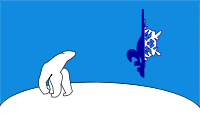Franco-Ténois
This articleneeds additional citations forverification.(July 2022) |
 Franco-Ténois flag | |
| Languages | |
|---|---|
| Canadian French,Canadian English,Franglais | |
| Religion | |
| MainlyRoman Catholic | |
| Related ethnic groups | |
| Franco-Albertans,Franco-Columbians,Franco-Ontarians,Fransaskois,French Canadians,Québécois,Acadians,Cajuns,French Americans,Métis,French |
Franco-Ténois,originating from the acronymTNO,the French term for theNorthwest Territoriesof Canada (Territoires du Nord-Ouest), refers to the widespread community offrancophoneswho reside in the Northwest Territories.
History[edit]
Francophones have a long history in the region. The first person of European descent to reach theGreat Slave Lakewas a francophone,Laurent Leroux.In 1786, Leroux built the trading postFort Resolutionand in 1790 he founded the originalFort Providence,20 km from the modern-day city ofYellowknife.At the time the Northwest Territories were brought under the jurisdiction of theGovernment of Canada,47% of the non-native population spoke French. French permeated every aspect of life in the Territories, from commerce to education. However, in 1892, the Northwest Territories (which at the time covered theCanadian Prairieswest ofSouthern Manitoba) abolished French as an official language. In 1984, its status as an official languages was restored in the Canadian territories.[citation needed]
French in the Northwest Territories[edit]
As of the 2006 census, only 440 residents of the Territories, representing 1.1% of the overall population, use French as their home language.[1]The francophone population in the Territories is very mobile, with many residents coming from more settled Francophone communities across the country and eventually leaving to settle elsewhere. While current figures show the average stay of francophones in the region is increasing, the trend towards outward migration continues. The Franco-Ténois also deal with substantial pressures to assimilate, brought on by the isolation of Northwest Territories communities and the existence of a plurality of languages and cultures there among which English takes precedence.
French is currently one of eleven official languages in the Northwest Territories, along withChipewyan,Cree,English,Gwichʼin,Inuinnaqtun,Inuktitut,Inuvialuktun,North Slavey,South SlaveyandTłįchǫ.
In 1984, theCanadian Government,pursuant to theCharter of Rights and Freedoms,introduced a bill in the House of Commons, Bill C-26, which would have made the Territories officially bilingual in French and English. The government of the Northwest Territories strongly objected to the proposed bill and the federal government subsequently dropped the measure. The government of the Northwest Territories then adopted anOfficial Languages Actin the same year that recognized eight official provincial languages, Inuktitut (which includes Inuvialuktun and Inuinnaqtun), Awokanak or Slavey, Dogrib, Chipewyan, Cree, Gwichʼin, English and French. The government of the Northwest Territories agreed to provide services in French under the condition that the federal government absorb the cost and fund the development of Native communities.
In March 1999, a Forum on French in the Northwest Territories exposed a widespread lack of government services in French. In 2000, theFranco-Ténois Federation,the weekly French newspaperl'Aquilonand five other parties sued the government of the Northwest Territories and the Government of Canada for not adequately applying the Official Languages Act and the Charter of Rights and Freedoms.[citation needed]
Community[edit]
The Franco-Ténois Federation (Fédération franco-ténoise) is the primary representative body for the Franco-Ténois community. A network of local organizations were created across the Territories in 1988 to band together isolated pockets of francophone settlement. Other than in Yellowknife, where the largest francophone population resides, local organizations exist in other areas of francophone settlement such asInuvik,Hay RiverandFort Smith.Initially, many of the local associations were created for the simple purpose of obtainingRadio-Canadaradio and television broadcasts. The creation of the separate territory ofNunavuthas cut off some francophone communities in the new territory from the larger base in the west.
The Franco-Ténois community is served by a weekly French language newspaper,l'Aquilon,which celebrated its 20th anniversary in January 2006. The community is also served with French language radio stations in major communities, and many cultural events across the territories. The francophone theatre troupe,Les pas frette aux yeux,is well known throughout the territories.
Yellowknife is served byCIVR-FM103.5, a community radio station; andVF213697.3 FM, a localIci Radio-Canada Premièrerepeater owned by L'Association Franco-Culturelle de Yellowknife.Ici Radio-Canada Télébroadcasts in Yellowknife and Hay River through locally owned repeaters.[citation needed]
Education[edit]
In 1988, a group of francophone parents in Yellowknife called for the creation of a French first-language education program. The government of the Northwest Territories asserted that the immersion program already in place was more than adequate. The group of parents sued the government, forcing the creation of the first French language program in 1989, with an initial class of nine children. Similar measures followed in Hay River and elsewhere across the Territories. A French school board was created in Yellowknife in 2000.[citation needed]
The Franco-Ténois flag[edit]

The Franco-Ténois flag was created in 1992. It features asky bluebackground, representative ofla Francophonie,with a curve separating the sky blue from a field of white in the bottom portion of the flag. Apolar bearposedpassant regardantis perched upon the curve, meant to resemble a snowy hill (in an image reminiscent of the official logo of the Government of the Northwest Territories). The curve itself represents the 60th parallel, above which the Territories are located. The bear looks up at a symbol in the upper right corner of the flag, composed of half afleur-de-lys(left half) and half a snowflake (right half). This is meant to represent the francophone community and its northern roots in thehyperboreanclimate of the Territories.[citation needed]
See also[edit]
References[edit]
- ^Statistics Canada,2006 Census Profile of Federal Electoral Districts (2003 Representation Order): Language, Mobility and Migration and Immigration and Citizenship.Ottawa, 2007, pp. 475, 479. (Figures combine single and multiple responses. Multiple responses for "French/English", "French/Other" and "English/Other" were allocated with one-half of all respondents placed in either linguistic category. Multiple responses for English/French/Other "were allocated with one-third of all respondents being placed in each of the three categories.)
